Making cities better with vacant spaces and ‘meanwhile use’
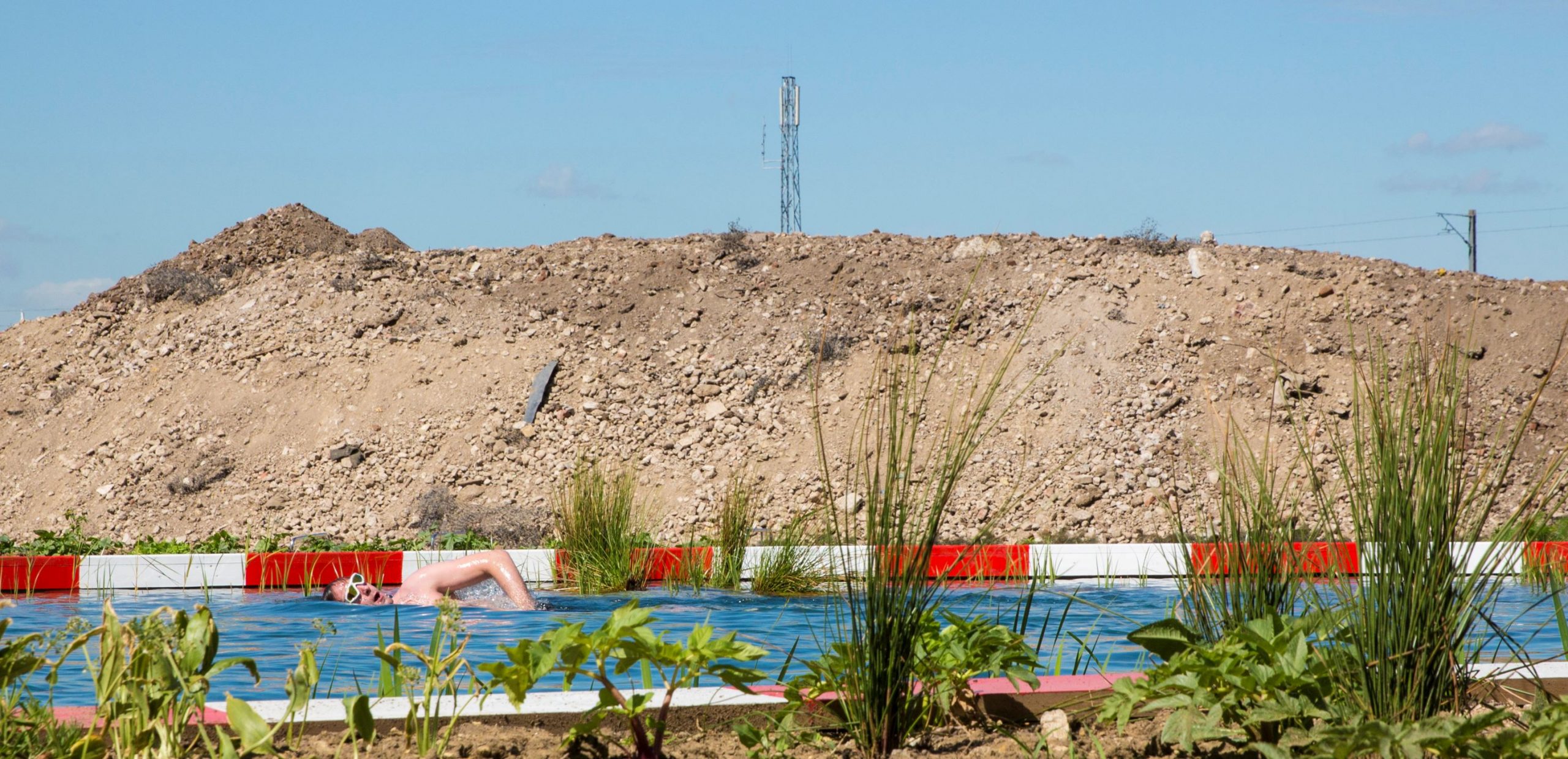
References
New forms of temporary art, design and architectural practice have burgeoned in recent years operating in vacant shops, buildings, and urban lots. Taking an experimental approach, these practices make interventions which activate underused space and catalyse participation and engagement with a range of public audiences. New terminology, from ‘pop-up’ to ‘meanwhile use,’ has entered our vocabulary to describe such activities. Whether self-initiated by creative practitioners, or in support of community-led projects, or even commissioned by developers and commercial operators, recent practices of temporary-use open up creative possibilities for how we can better utilise vacant spaces in the contemporary city.
The history of urban vacancy is not straightforward, of course. Vacant space and land have often been perceived as leftover, abandoned or remnant, as space which has ‘failed’ the user and as shameful evidence of urban decline and economic blight. Consider Detroit, the shrinking city of the 1990s which has lost 25 percent of its population in the last 10 years and where one third of the entire city area lies derelict. Closer to home, across Melbourne, empty shopfronts and offices are the visible legacy of the COVID-19 pandemic. From January to July 2021, vacancies in the city’s Central Business District were over 10 percent, the city’s highest vacancy rate in twenty years. Even during Australia’s last major recession in 1990, commercial demand in the heart of the city was higher.
When the value of real estate is the barometer, vacancy becomes a measure of market failure. But if value is not financially calculated, then vacancy is less easy to determine – in fact, vacant land may provide a place of possibility for some people.
Squatting, for example, has traditionally been an opportunistic way to make use of emptiness and redundancy and one in which the economically vulnerable benefit. As the Catalan architect and theorist Ignasi de Solà-Morales noted in the 1990s, vacant land – or as he termed it, ‘terrain vague’1 – provides places which are conspicuously free of capital, and instead offer escape and an alternative to mainstream uses that dominate urban real estate.
Urban vacancy can be reconceptualised not as a blight, but rather, an opportunity.
Empty and uninhabited buildings are symptomatic of the ebb and flow of changing patterns of living, working and trading in urban areas. But if they have been historically undervalued in the past, contemporary urban development has increasingly started to acknowledge that urban vacancy, temporary use, and reoccupation are cyclical phenomena that open up flexibility for urban development, enabling cities to be used more productively, and, conversely, exploited more intensively by real estate.
Unexpected forms of occupation
Regardless of the motive, temporary use can lead to different and unexpected forms of occupation, opening questions on future use that include audiences and uses usually left out of more conventional planning conversations. The unintended use of buildings and vacant urban sites offers another side to the carefully planned and managed domain of conventional urban development.
Following the fall of the Berlin Wall, Berlin’s planned redevelopment faltered in the mid 1990’s and a lively temporary use scene developed on much of the derelict land and in spaces between buildings. From improvised parties, to nomadic bars and clubs, young people attracted by low rents populated and supported the city. What was traditionally considered a problem in planning terms became an advantage, as the city became a hub for creative countercultures. Urban neighbourhoods that have become a magnet for informal uses in this way capture a remarkable human story that contains its own form of beauty. Provisional, practical, and full of the multiplicity of rich everyday experience, they are some of the most exciting and lively spaces in our otherwise zoned, regulated and privatized urban fabric.
Urban designers and planners have eventually started to understand the urgency of capturing this informality. Research around temporary urbanism has multiplied amongst architects and urbanists in the last decade. In the early 2000s, Urban Catalyst (a research project founded by Phillipp Misselwitz, Phillipp Oswalt and Klaus Overmeyer) investigated the temporary use scene, fascinated by the contradiction between formal planning and the power of informal public use. They documented over 100 examples of temporary uses in their publication Urban Pioneers and asked the question: “If temporary uses are an important factor for urban development, how can they be incorporated into planning and urban development? How can planning open itself up to the unplanned? And, conversely, can the unplanned be planned, the informal formalized?” 2 Their investigations contributed to a broader understanding that the value of temporary uses is less about the formal or spatial qualities of urban spaces, and more about the processes which enable everyday citizens to use them spontaneously and freely.
Raumlabor Berlin is one example. Founded in their eponymous city in 2001, this creative collective of nine core practitioners working at the intersection of architecture, city planning, and urban intervention use temporary, large-scale props to activate and regenerate abandoned public spaces. Resistant to being labelled ‘temporary’ architects, their intention is to consider how their interventions can catalyse further urban transformation. In 2003, they created a project in Halle Neustadt, a city development built by the German Democratic Republic in East Germany that, since 1990, has seen most of its population move and many of its original buildings become vacant. For two months in the summer, they transformed an empty high-rise building into Hotel Neustadt, a hotel and festival. In essence, they prototyped the transformation from empty office to community resource through temporary use, with the intention of creating long-term repercussions for the future life of the vacant building.
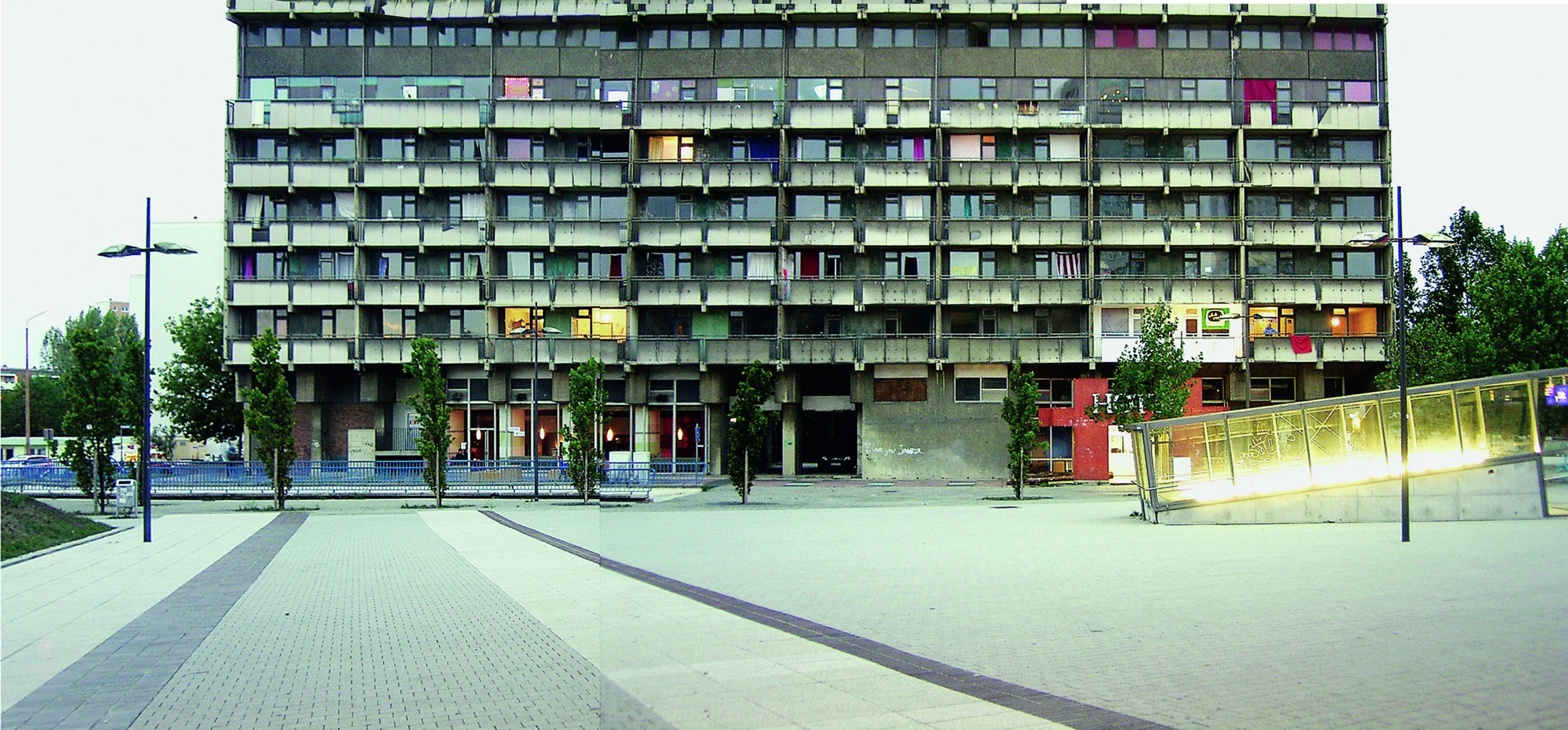
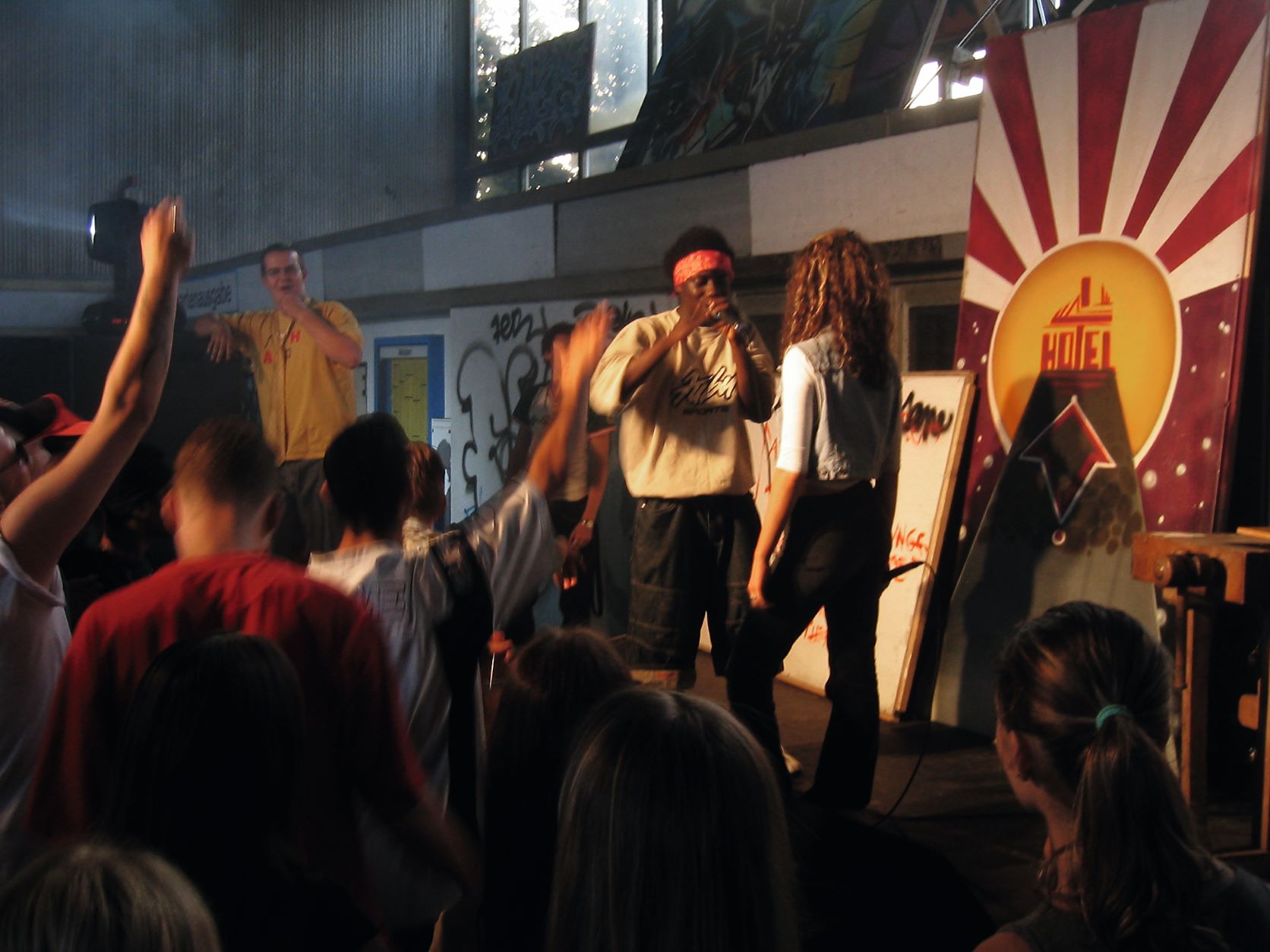
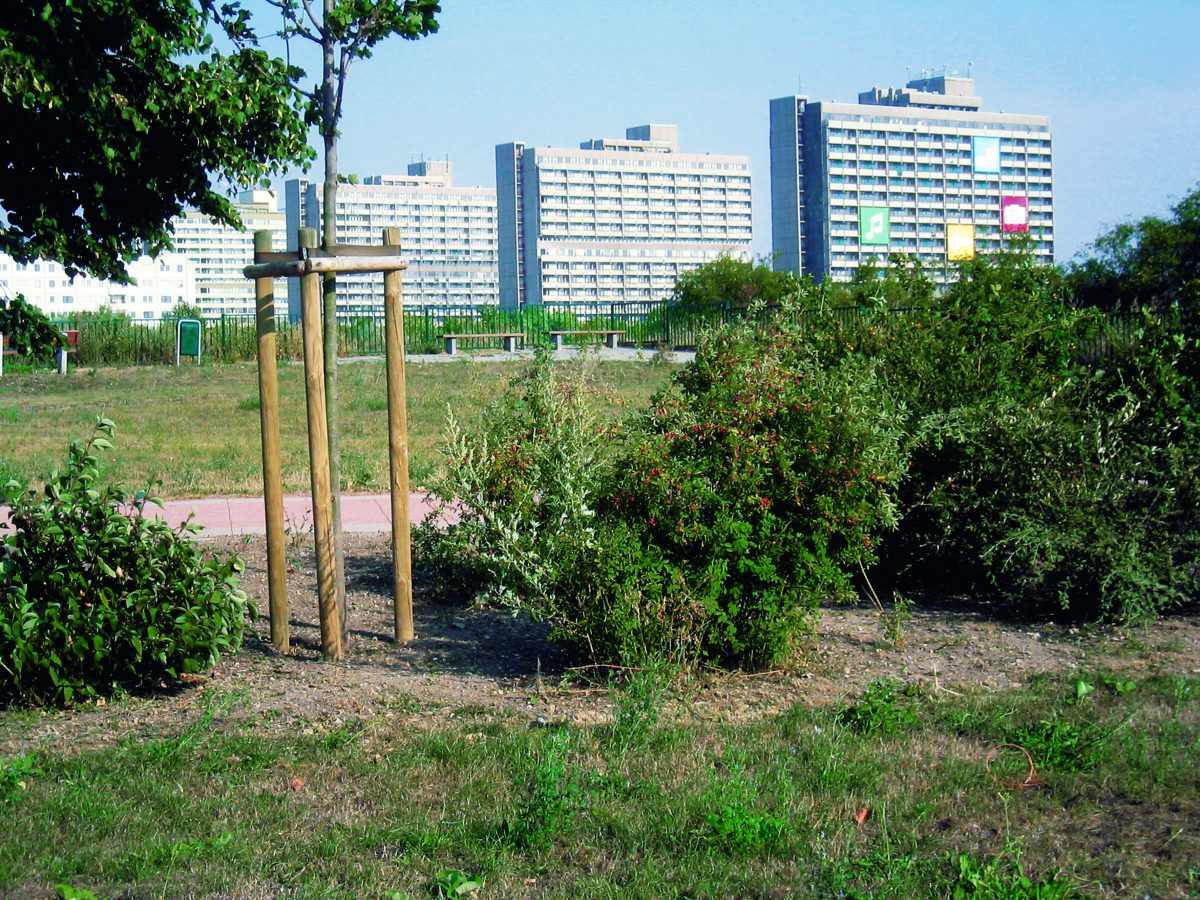
Over the last four years they have also worked with locals and government bodies, such as the Berlin Government and the German Federal Cultural Foundation, on the site of the former Tempelhof Airport, to reimagine the now-defunct airfield. Using temporary structures and programmes, they have prototyped several experimental initiatives, notably the Floating University in 2018, which saw 25 different universities from around the world deliver experimental workshops and seminars to Berliners in a series of half-raft, half-scaffold structures floating in the former runway rainwater retention basin.
Collectively negotiating the city
Many projects for temporary and interim uses prototype forms of self-organisation that are unusual for conventional architecture and are considered more commonly part of socially engaged art practice. The benefits of an approach rooted in socially engaged and relational art methods – art rooted in human relations, and relations to the context around them – is that it sees the city as a contested space where democracy is played out and frictions are explicit. In relational forms of practice, artefacts are ‘co-made’ – constructed by the artists and architects who create the work, but also through the interpretations of the people who experience it. This approach implies that our relationships with artefacts and spaces is mediated through differences in experience and identity, where art is in a continuous state of being made and remade by the public.
When understood in this way, temporary projects are as much about the relations between people and the works, as they are about the works themselves. Dutch artist Jeanne van Heeswijk works within temporary spatial and place-based contexts and describes her practice as a means of ‘collectively negotiating the conditions of our existence’. She explains: “In a lot of places where I work people feel left out of the way the spaces are formed, shaped, governed and financed. They no longer understand why the spaces where they live and work look the way they do. Through my work I try to collectively understand and unravel – to de-abstract.” For van Heeswijk, this way of working provides opportunities for new social interactions, and ways to participate collectively. Critically many who practice relational art see the focus of their practice as intervening in the ‘production’ of space to test out new forms of living – as the art critic Nicholas Bourriaud writes: “The role of artworks is no longer to form imaginary and utopian realities but to actually be ways of living and models of action within the existing real.”3 The claim is that relational practice can prototype an arena of exchange with social benefits and have a broader political intent that is in the public interest.
Not surprisingly, alongside these tactical temporary practices, more strategic planning and development tools have expanded to harness the potential for temporary and interim use. The term ‘meanwhile use’ has entered common vocabulary, describing pop-up cafés or empty shop use, or even long-term temporary uses of empty property and land. ‘Meanwhile use,’ as popularised in planning and development policy, extends beyond just temporary use of vacant spaces – it also suggests actively revitalising empty spaces in urban areas via actions in the ‘meanwhile’ to take advantage of a window of opportunity on a site before it is redeveloped, to provide an interim income stream for the landowner, or to enhance the attractiveness of a place to potential future tenants and investors.
Whilst many people are traditionally excluded from more powerful and mainstream forces of real estate, planning and urban development, meanwhile and temporary uses in vacant spaces provide the opportunity for greater public participation in city-making.
Over the last decade, London’s rapid development has seen ‘meanwhile’ strategies proliferate. In 2010, in advance of the London Olympics, the ‘Meanwhile London’ competition asked for proposals for three sites in the Royal Docks area of East London. The competition was part of a strategy initiated by the now defunct London Development Agency (LDA), the Mayor of London and the Mayor of Newham to attract attention and investment. Four winners were picked for the three sites, including the ‘Canning Town Caravanserai’ at Canning Town, led by Ash Sakula Architects, a practice known for their community focused projects. Newham Borough Council offered the winning teams use of the land free of charge, with $7,500 (£4,000) ‘Kickstarter’ money from a community interest company. Ash Sakula won the site for four years and began to develop a volunteer programme and a funding mechanism that addressed the potential for public spaces to be operated neither for profit, nor run by local authorities but rather, by self-organization through nascent social and micro-enterprises. Inspired by French art and architecture collective EXYZT, they planned an inclusive cultural space somewhere between a park, an adventure playground and a community garden. Ash Sakula co-founder Cany Ash acknowledged the value of the collective space and relationships created when she describes how a local bus driver was “amazed by the richness of a place that could exist behind a simple hoarding; the kind of place that could potentially exist in hundreds of interstices of the city.” But she was simultaneously cautious about the dangers of upscaling meanwhile use strategy and in doing so “de-risking the process, trusting the private sector to supply opportunities and professionalizing the field.” 4



In the ten years since the Meanwhile London competition, ‘meanwhile use’ has now entered planning policy guidance and forms an active part of the new London Plan. Organisations, services and professionals have evolved to explicitly roll out the design and management of meanwhile activation strategies for vacant spaces. Increasingly, there is a strategic goal of attracting and establishing direct relationships with local communities, institutions, and citizens at large with the goal of creating uses in the public interest. Alongside these objectives, temporary uses are seen as pivotal in building location and destination brands helping create lively site images that can attract young people, creatives, and innovative enterprises for tourism or economic benefits. In this respect, art, culture, and creativity operate as strategic levers, with different entanglements and values operating uneasily alongside urban developments’ business models.
Who does ‘meanwhile use’ serve?
The wide spectrum of approaches to the occupation of redundant space – from temporary and ‘meanwhile use’ to pop-ups – raises a larger question around exactly who such uses serve. On the one hand, these approaches often create valuable opportunities for creative, community and cultural uses with clear public value, supporting collective and community-organizing initiatives, and expanding experimental, socially-engaged practices that are in the public interest. On the other there is concern that temporary use has been instrumentalised by developers and planners for their commercial benefit. For some critics, meanwhile uses are even seen as exploitative. Sociologist Fran Tonkiss uses the term ‘austerity urbanism’ to denote the way improvised temporary uses are now used as back-fill by voluntary and non-profit actors in reaction to the withdrawal of the state. She sees them as part of “‘roll-with-it’ neo-liberalization in which precepts of self-reliance, entrepreneurialism and flexibility have become normalized and generalized”.5
Despite these critiques, and in the case of large-scale and long-term regeneration or renewal of vacant urban land, meanwhile uses do have the potential to accommodate more agile master-planning and be more flexible in delivering amenities which benefit communities along the way, rather than blighting urban blocks with hoardings for years on end. Furthermore, it’s possible to reconceptualize the process of master-planning redevelopments entirely, so that rather than create plans with rigid and fixed outcomes, a flexible vision is created that operates as a more loosely designed framework evolving over time. Considered in this way, meanwhile uses can be co-opted as a strategic tool for action within sites and contexts before delivering on permanent uses and functions; to prototype and test possibilities and opportunities rather than deliver a fixed end product.
At King’s Cross in London, celebrated as one of London’s major regeneration success stories, the developers Argent St George proposed a vision entitled ‘Principles for a Human City,’ which placed emphasis on “long-term stewardship, high quality, inclusive design, accessible public realm, diversity, and engagement.” These principles were envisaged as part of a “flexible” masterplan which put place-making at its heart, that was to be implemented incrementally over the 15 years that the project would take to be complete. Their intention was for Kings Cross to be accessible throughout the development period. Central to this effort was over 70,000 m2 of public realm that provided space for major events, community group meet-ups, art installations and even socially engaged art projects, like the Kings Cross Pond Club by Rotterdam-based architectural firm Ooze, and community sites, like the Skip Garden by eco charity Global Generation.
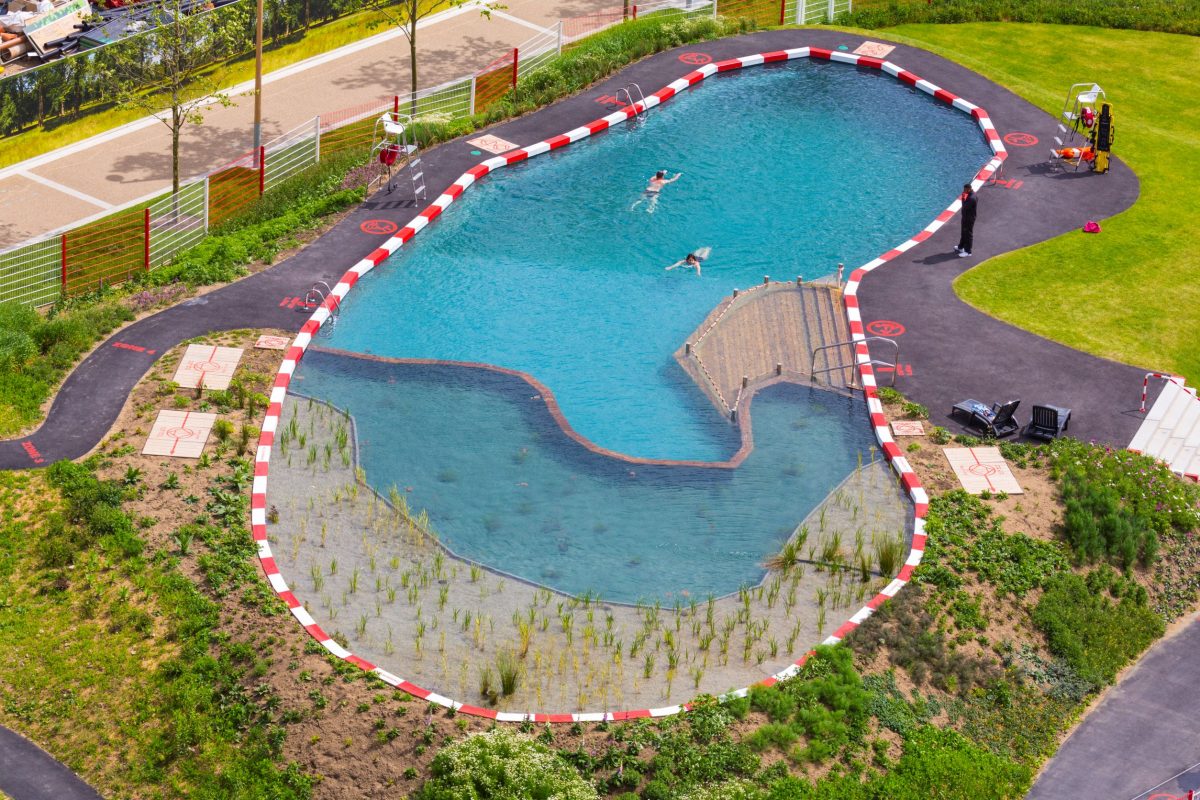
Research is currently underway, through a European Union initiative, to assess the long-term impact of such flexibility—specifically, how it has benefitted locals through access to employment, training, high quality housing, public spaces and amenities. At King’s Cross, the developer Argent St George was primarily responsible for making decisions on the types of meanwhile projects to develop and to a certain extent they controlled most aspects of what happened on the site to maintain a coordinated image, particularly with regards to their redevelopment brand. However, out of necessity, the wide array of meanwhile projects occurring at King’s Cross was developed in cooperation with a diverse range of local businesses, residents, local institutions or community groups. From tactical interim use of vacant real estate to deliberate and strategic ‘meanwhile use’ policy and commissioned art projects, the temporary uses, by their very nature, involved collective collaboration with residents and local stakeholders. In this sense, they became a powerful catalyst for more unruly examples of collaborative placemaking to unfold via various degrees of ownership, agency and legitimacy.
Against the charged backdrop of urban vacancy, it is clear that exciting and inventive ‘meanwhile’ strategies are being pursued by organisations, citizens, planners, practitioners, researchers, as well as urban developers across contemporary cities. These new experiments start to come closer to answering the questions posed by Urban Catalyst twenty years ago about how planning can ‘open itself up to the unplanned.’
The social, economic and cultural backgrounds of the people who improvise and make use of these spaces is key. Whilst many people are traditionally excluded from more powerful and mainstream forces of real estate, planning and urban development, meanwhile and temporary uses in vacant spaces provide the opportunity for greater public participation in city-making. Using these approaches, urban vacancy can be reconceptualised not as a blight, but rather, an opportunity. Optimistically, it’s clear that incorporating temporary uses and ‘meanwhile’ space can provide an opportunity for a messier approach to urban planning and development: one that accommodates people, and the complexities of time.
- Ignasi de Solà-Morales Rubió, Presente y futuros. La arquitectura en las ciudades, 1996.
- Urban Catalyzt, 2013.
- Nicholas Bourriaud, Relational Aesthetics, 2002.
- Cany Ash as cited in Mel Dodd, Spatial Practices, Modes of Action and Engagement with the City, 2020.
- Fran Tonkiss, Austerity urbanism and the makeshift city, 2013.